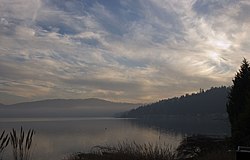Lake Sammamish
| Lake Sammamish | |
|---|---|
 |
|
| Location | King County, Washington |
| Coordinates | 47°36′59″N 122°05′22″W / 47.6164888°N 122.089427247°WCoordinates: 47°36′59″N 122°05′22″W / 47.6164888°N 122.089427247°W |
| Primary inflows | Issaquah Creek |
| Primary outflows | Sammamish River |
| Basin countries | United States |
| Max. length | 7.3 mi (11.7 km) |
| Max. width | 1.5 mi (2.4 km) |
| Surface area | 19.8 km2 (4,897 acres) |
| Average depth | 58 ft (18 m) |
| Max. depth | 105 ft (32 m) |
| Surface elevation | 30 ft (9.1 m) |
Lake Sammamish is a freshwater lake 8 miles (13 km) east of Seattle in King County, Washington, United States. The lake is 7 miles (11 km) long and 1.5 miles (2 km) wide, with a maximum depth of 105 feet (32 m) and a surface area of 8 sq mi (21 km2). It lies east of Lake Washington and west of the Sammamish Plateau, and stretches from Issaquah in the south to Redmond in the north. At Issaquah it is fed by Issaquah Creek, and at Redmond it drains to Lake Washington via the Sammamish River.
The 98 sq mi (250 km2) Lake Sammamish watershed stretches from Redmond through Bellevue, and Issaquah to Preston and Hobart, and consists of numerous creeks which flow into the lake. Issaquah Creek is the largest tributary, furnishing over 70% of the lake's inflow.
The area surrounding Lake Sammamish has been, in recent times, the most rapidly growing suburban district in the Greater Seattle Metropolitan Area. During the late 1990s and early 2000s, the cities of Redmond, Snoqualmie, Fall City, Issaquah and Bellevue have grown substantially. The town of Sammamish was incorporated in 1999 because of suburban growth.
Historically, runoff from the high precipitation in the lake's watershed (nearly twice the 35 inches that Seattle gets each year) was absorbed by the surrounding forests. Loose, sponge-like forest soils virtually eliminated runoff during winter storms and recharged groundwater aquifers which then released fresh water to streams in the dry summer months. With rapid urbanization the forests have been replaced by impervious surfaces—roofs, roads, parking lots—and stormwater runoffs have increased flooding. The stormwater runoff carries sediment loads and toxic pollutants into streams and ultimately the lake, which generally has a negative impact on lake water clarity as well as fishes and wildlife.
...
Wikipedia
